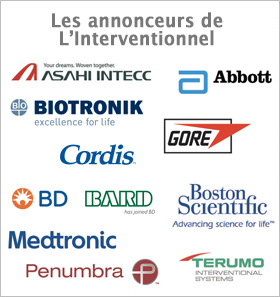European Corner
Publié le 25 mar 2024Lecture 6 min
Current algorithm about the endovascular treatment of femoropopliteal atheromatous lesions ?
Hany ZAYED, Consultant vascular and endovascular surgeon, Guy's and St Thomas' NHS Foundation Trust, London (United Kingdom)

Dans cette nouvelle rubrique, nous donnons la parole à des experts européens. Pour cette première session, rencontre avec Hany ZAYED, Consultant vascular and endovascular surgeon, Guy's and St Thomas' NHS Foundation Trust, London (United Kingdom).
• L’INTERVENTIONNEL
Please give few words about your education and specialty, your training, your hospital, your current position, and your main focuses about vascular diseases.
Hany ZAYED - I am a consultant vascular and endovascular surgeon at Guy’s and St. Thomas’ Hospital in London. I have a specialist interest in limb salvage techniques and peripheral arterial disease. I had most of my training in Cairo university teaching hospitals, Egypt, before coming over to the UK where I completed two fellowships prior to my consultant appointment.
Algorithm for treatment of femoropopliteal lesions ?
Approach
• L’INTERVENTIONNEL
What is your favorite approach ? Why ?
Hany ZAYED - My favorite approach for access is ultrasound-guided antegrade common femoral artery access. I prefer antegrade femoral access because it provides better support and pushability. This is particularly important in calcified long chronic total occlusion (CTOs) and/ or extensive tibial disease.
• L’INTERVENTIONNEL
Please describe what types of devices that you use to do it.
H. ZAYED - I perform the antegrade common femoral artery vessel puncture/access under ultrasound guidance in a longitudinal view. I usually start with a micro-puncture set then upsize to 4 Fr sheath when I am happy with my wire position. This allows me to clearly identify the femoral bifurcation, guide my catheter into the superficial femoral artery (SFA) rather than the profunda femoral artery (PFA). It also allows me to plan my puncture site in a position to give me enough space to manipulate my wire/catheter to engage the SFA origin in case of flush SFA occlusion.
• L’INTERVENTIONNEL
What do you think about radial approach ?
H. ZAYED - I have to admit that I rarely use the radial approach in my practice. If I need upper limb access, I tend to use the brachial artery. Having said that, it is likely that radial access will play a bigger role in the peripheral endovascular practice due to its convenience both to patients and to physicians based on the coronary practice.
Crossing
• L’INTERVENTIONNEL
Are you a subintimal or intraluminal crossing believer? What are the reasons?
H. ZAYED - I tend to try intra-luminal crossing first when treating femoropopliteal chronic total occlusion (CTO). This approach leaves the door open for most of the vessel preparation tools (such as atherectomy devices and intravascular lithotripsy) which might be required according to the nature of the occlusion. Having said that, I believe that realistically, the wire usually moves between intraluminal and subintimal planes during recanalization of long femoro-popliteal CTO. It is therefore difficult to be 100% sure that my wire remained intraluminal throughout the whole length of the CTO.
• L’INTERVENTIONNEL
Could you describe your guidewire escalade to cross chronic total occlusion?
H. ZAYED - I spend a considerable time studying the preoperative cross-sectional imaging, which is CT angiogram in most of the cases. This helps me better understand the composition/ nature of the occlusion, the degree of calcification and allows me to predict how it will respond to attempts of intra-luminal recanalization, vessel preparation devices and re-entry techniques.
I initially try to penetrate the top cap of the femoro-popliteal long CTOs using 0.035 wires. I usually start with a straight-stiff hydrophilic wire guided by an angled catheter (BER 2) using drilling technique. My next choice would be an 0.018 wire, again supported with an angled catheter. If this fails, I might consider either CTO wire or switch to subintimal recanalization.
• L’INTERVENTIONNEL
How do you proceed in case of crossing failure (re-entry device? Retrograde access?)
H. ZAYED - I have a low threshold to use re-entry devices when spontaneous reentry following subintimal recanalization is not achievable. We have a reasonably good success rate with targeted re-entry using re-entry devices and therefore we tend to use retrograde access less often.
Vessel preparation
• L’INTERVENTIONNEL
What are your techniques of vessel preparation?
H. ZAYED - This really depends on my crossing technique and the nature/ composition of the plaque/occlusion, as below:
1- Intra-luminal recanalization with heavy calcification: Intravascular lithotripsy (IVL) with a low threshold for scaffolding/stenting;
2- Intra-luminal recanalization without heavy calcification: Rotational atherectomy + Drug-coated balloon (DCB) ± stenting;
3- Sub-intimal recanalization: Plain balloon angioplasty (PBA) followed by stenting.
• L’INTERVENTIONNEL
How do you evaluate the quality of vessel preparation?
H. ZAYED - In situations 1 and 3, I tend to accept satisfactory luminal gain based on angio as evidence of good vessel preparation prior to deploying the stents. In situation 2, I tend to use IntraVascular Ultra-Sound to determine whether DCB will be enough or if scaffolding will be necessary.
• L’INTERVENTIONNEL
What are your thoughts about atherectomy, IVL or scoring balloons?
H. ZAYED - I think they do play an important role. Both atherectomy and IVL devices are already incorporated into my algorithm as described above.
• L’INTERVENTIONNEL
Do you see any interest in IVUS or OCT for the SFA?
H. ZAYED - I do believe that intra-vascular cross-sectional imaging is particularly useful if we were to decide if stenting is necessary or not and guide the decision regarding the optimal position/ location of the stents as mentioned in my protocol.
Treatment
• L’INTERVENTIONNEL
For medium length lesion, what is your strategy between DES & DCB?
H. ZAYED - For Medium lesions (<15 cm) I tend to follow the above-mentioned protocol. For longer lesions, I have a low threshold to use stenting. This is because I believe that for such a long lesion, it is very unlikely that any vessel preparation technique will achieve adequate luminal gain throughout the whole lesion length.
• L’INTERVENTIONNEL
Do you have still any indication for bare metal stent?
H. ZAYED - Bare-metal (Supera) stents will be my first option if scaffolding is needed particularly in calcified lesions.
• L’INTERVENTIONNEL
What is the place of self-expendable covered stents in your strategy?
H. ZAYED - In my practice, self-expandable covered stents have a role, mainly in two occasions: First to deal with procedural complication such as bleeding during femoro-popliteal recanalization. Second, as a pave-and-crack technique in heavily calcified CTOs which did not respond satisfactorily to adequate vessel preparation.
• L’INTERVENTIONNEL
How do you treat re-stenosis?
H. ZAYED - In our unit, we tend to treat stent restenosis with DCB angioplasty. For stent occlusion, we tend to try to perform debulking using rotational atherectomy, followed by DCB.
• L’INTERVENTIONNEL
Any ongoing/future studies that would help clarify femoropopliteal treatment?
H. ZAYED - I think we still have a gap in real-time evaluation of the haemodynamic response to endovascular treatment. Studies on real-time assessment of tissue perfusion pre and post endovascular treatment will be invaluable and will certainly help guide our decision-making.
Future & perspective
• L’INTERVENTIONNEL
What are your thoughts on Limus technologies?
H. ZAYED - I believe Limus technologies will play an increasing role in CLTI management. I would really like to see more data on how Limus technologies perform on the long-term and how do they compare to Paclitaxel technologies.
• L’INTERVENTIONNEL
BASIL-2 BEST-CLI have modified your strategy in CLTI patients(1) ?
H. ZAYED - I believe that both trials have been very informative and valuable in answering the questions there were designed to address. However, it isimportant to note that only around 20% of the CLTI population are in fact suitable for both open and endovascular treatments. These two landmark studies have provided enough evidence to guide the management of in these patients, who still representthe minority ofthe overall CLTI cohort. Regardless of the best revascularization modalities in suitable patients,these studies highlighted the unacceptably low survival rate in these patients. I believe that our main focus should now be directed towards understanding the reasons behind this high mortality rate and what measures we need to implement to improve the survival of CLTI patients.
Attention, pour des raisons réglementaires ce site est réservé aux professionnels de santé.
pour voir la suite, inscrivez-vous gratuitement.
Si vous êtes déjà inscrit,
connectez vous :
Si vous n'êtes pas encore inscrit au site,
inscrivez-vous gratuitement :


